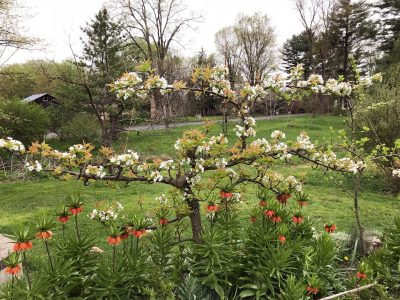Plants I Like
/1 Comment/in Flowers/by Lee ReichFrom Ancient Egypt
King Tut is alive and well, very well in fact. I’ll cut to the chase: This particular King Tut is a variety of papyrus (Cyperus papyrus) that I planted a year ago in spring. Papyrus doesn’t tolerate temperatures down to freezing, so this far north King Tut is billed as an annual. But rather than let the King die in winter, I was so smitten by him that in autumn I moved him in his pot indoors to a sunny window. There he clung to life and, with warm, sunny weather, got growing again this past spring.
In contrast to regular papyrus, which grows 5 to 9 feet tall, King Tut’s claim to fame is that he’s a dwarf, billed as rising 4 to 6 feet high. My King Tut only gets about 3 feet high. 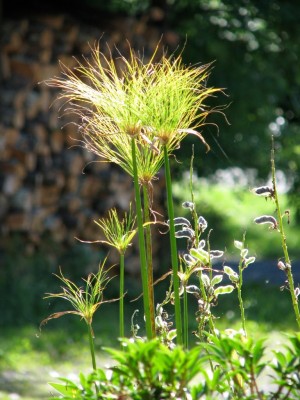 All papyrus have a very distinctive and attractive appearance. The base of the plant is a clump of grassy leaves from which rise tall, leafless stalks which are capped by grassy-leaved mopheads looking something like the ribs of an umbrella. A houseplant relative of papyrus, Cyperus alternifolius, is commonly called umbrella plant.
All papyrus have a very distinctive and attractive appearance. The base of the plant is a clump of grassy leaves from which rise tall, leafless stalks which are capped by grassy-leaved mopheads looking something like the ribs of an umbrella. A houseplant relative of papyrus, Cyperus alternifolius, is commonly called umbrella plant.
Many, if not most, problems with plants in general can be attributed to too much or too little water. King Tut (and umbrella plant) are very easy to grow because they love water up around their ankles. All the plant needs is a deep saucer in which the pot can sit, with the saucer kept full of water. Not that King Tut demands water around his ankles. It’s just that consistently moist soil is needed, which means close attention to watering or standing in a water-filled saucer.
King Tut grows very rapidly, so this spring I divided the one King Tut plant into two and potted each one up separately. I also cut back all the old stalks. Although I tossed them in the compost pile, I could have made them into sandals, a boat, paper, or any one of the other papyrus products of ancient Egypt.
A Nice Weed
A few weeds garner my respect and my affection. Over the past few weeks, spotted spurge (Euphorbia maculate) has become one such weed. Spotted spurge has mouse-ear sized leaves, each with a reddish blotch along part of its main vein, and the leaves line up in a very orderly manner along the stems. 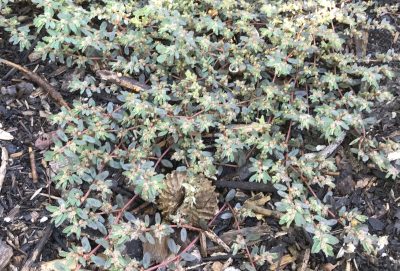 The definitive identifier for this weed is the way the stems spread out, flat, on top of the ground. In sun, no part of the plant rises more than a half an inch above ground level.
The definitive identifier for this weed is the way the stems spread out, flat, on top of the ground. In sun, no part of the plant rises more than a half an inch above ground level.
Mostly, I see spotted spurge growing in the wood-chip mulched paths in my vegetable garden. The amazing thing about this plant is the way it keeps sprouting in the paths. Even during the dry weeks of last June, spotted spurge kept sprouting. Not that it doesn’t also turn up following recent rains and in the irrigated, planted beds. I can’t help but respect a plant that can keep showing up under such adverse conditions.
Whenever I see the flattened stems, I reach down and pull it out, roots and all. My affection for this plant comes from the ease with which it is removed. The stems don’t form roots where they touch ground, as many other plants do, so grabbing the center of the clump gets rid of a square foot of weeds in one fell swoop. How satisfying.
Removing the plants is important. Spotted spurge is a summer annual that thrives in heat. Left alone, tiny flowers in each leaf axil give rise to tiny seeds that germinate through summer or, when weather warms, next year. It’s important not to dawdle in removing the plants because only a couple of weeks of growth are needed before young plants are old enough to flower and make seeds.
From Cosmos
I’m not usually a big fan of flower breeders’ new and wondrous creations, such as blue roses or tulips that look like peonies or peonies that look like tulips. That said, I’m quite enthralled with some cosmos I planted this spring that have been bred to look not very cosmo-ish.
What I’ve always liked about cosmos is their lack of pretension. The flowers are simple and sit singly atop tall stalks of sparse but feathery leaves. So along comes cosmos Rose Bon Bon. 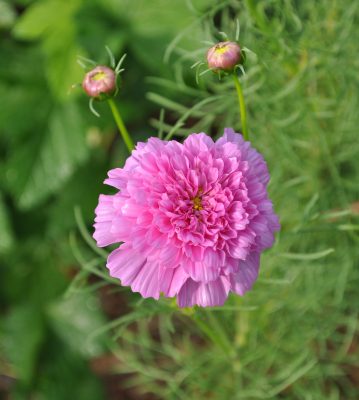 As a cosmos fan, I figured I’d try Rose Bon Bon in spite of the fact that the flowers are double, which means they have multiple rows of petals. More complex and, hence, less cosmo-ish.
As a cosmos fan, I figured I’d try Rose Bon Bon in spite of the fact that the flowers are double, which means they have multiple rows of petals. More complex and, hence, less cosmo-ish.
Rose Bon Bon flowers, all of them soft pink, are beautiful. They’re still cheery, just like regular cosmos, frilly and cheery in this case. The name Rose Bon Bon notwithstanding, they do NOT look like roses.
In the Wild
/0 Comments/in Design, Flowers, Fruit, Gardening/by Lee ReichRow, Row, Row My Boat, and Then!
Paddling down a creek — Black Creek in Ulster County, New York — yesterday evening, I was again awed at Mother Nature’s skillful hand with plants. The narrow channel through high grasses bordered along water’s edge was pretty enough. The visual transition from spiky grasses to the placid water surface was softened by pickerelweeds’ (Pontederia cordata) wider foliage up through which rose stalks of blue flowers. Where the channel broadened, flat, green pads of yellow water lotus (Nelumbo lutea) floated on the surface. Night’s approach closed the blossoms, held above the pads on half-foot high stalks, but the flowers’ buttery yellow petals still managed to peek out.
Soon I came upon the real show, as far as I was concerned: fire engine red blossoms of cardinal flower (Lobelia cardinalis). Coming upon this flower in the wild is startling. Such a red flower in such shade?
So many shade plants bear white flowers which, after all, are most easily seen in reduced light. Only twice before had I come upon cardinal flower in the wild, and both times the blooming plant was in deep, deep shade; it was a rare treat to see such a lively color in the shade.
Though the stream bank was not in deep shade, the cardinal flower was still a treat. And not just one cardinal flower but groups of them here and there along the way. 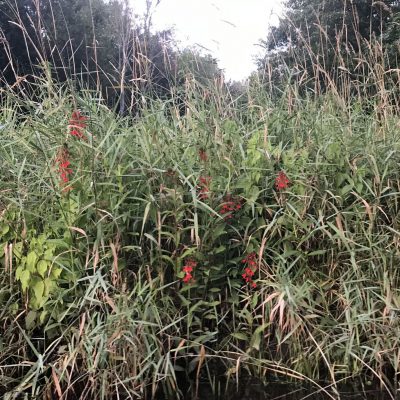 More than I have ever seen in the wild. (In Chanticleer Garden outside Philadelphia is a wet meadow planted thickly with cardinal flowers.)
More than I have ever seen in the wild. (In Chanticleer Garden outside Philadelphia is a wet meadow planted thickly with cardinal flowers.)
Nature’s Hand
Two other landscape vignettes come quickly to mind when I marvel at natural beauty.
The first are the rocky outcroppings in New Hampshire’s White Mountains; placement of these rocks always looks just right. In addition, the flat areas against the rocks and in rock crevices in which leaves have accumulated to rot down into a humus-y soil provide niches for plants. Among the low growing plants are lowbush blueberries and lingonberries.
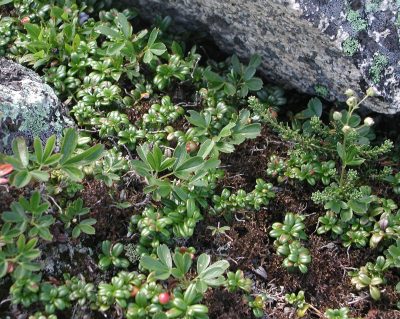
Lingonberry in White Mountains
Good job at “edible landscaping” Ms. Nature!
The other vignette was (one of many) in the Adirondack Mountains. Picture a clump of trees and a large boulder. Now picture those trees on top of the boulder, their roots wrapping around and down the bare boulder until finally reaching the ground on which the boulder sat. A scene both pretty and amazing.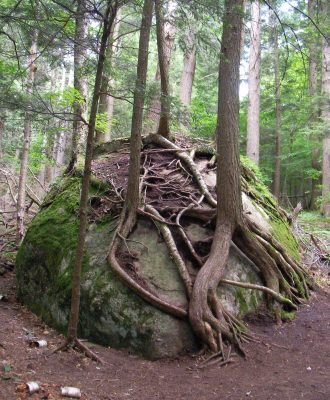
But My Fruits and Vegetables are Better(?)
Mother Nature might have it in the landscape design department; not when it comes to growing fruits and vegetables though. There may be some disagreement here: I contend that garden-grown stuff generally tastes better. And for a number of obvious reasons.
In the garden, most of what we grow are named varieties, derived from clones or strains that have been selected from among wild plants, or have been bred. Named varieties generally are less bitter, sweeter, and/or more tender. Perhaps also high-yielding and pest-resistant.
In some cases, “cultivated” plants offer too much of a good thing. Humans long sought to sink their teeth into the sweetest sweet corn, harvesting ears at their peak of perfection and then whisking them into already boiling water to quickly stop the enzymatic conversion of sugars to starches. In the 1950s, a “supersweet” gene was discovered that quadrupled the sugar content of sweet corn — too sweet for me and and lacking the richness of an old-fashioned sweet corn variety such as Golden Bantam.
A nutritional case can be made against cultivated varieties of plants. Studies by the US Department of Agriculture have shown modern fruits and vegetables to be lower in nutrients than those tested 50 or so years ago. Have we excessively mined our soils of minerals? No. Breeding for bulk, along with pushing plant growth along with plenty of water and nitrogen fertilizer, has diluted the goodness in plants.
In Eating on the Wild Side Jo Robinson contends that breeding for sweeter and less bitter plants inadvertently selects for plants lower in many nutrients and phytochemicals.
All this makes a good case for growing more “old-fashioned” varieties, such as heirloom tomatoes and paying closer attention to how plants are fed.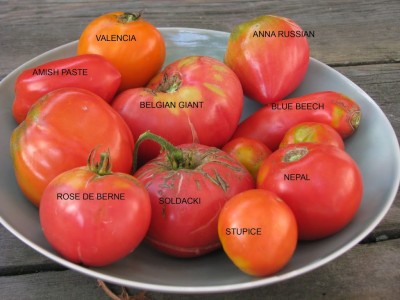 (Compost is all my vegetables get.) And perhaps focussing more on what food really tastes like. Does Sugarbuns supersweet really taste like corn. Or a candy bar?
(Compost is all my vegetables get.) And perhaps focussing more on what food really tastes like. Does Sugarbuns supersweet really taste like corn. Or a candy bar?
And eat some wild things. Purslane is abundant and, to some (not me) tasty now. As is pigweed, despite its name, a delicious cooked “green.” I mix it in with kale and chard for a mix of cultivated and wild on the dinner plate.
Watering — in the Rain?
/5 Comments/in Fruit, Gardening, Houseplants, Soil/by Lee ReichWhy Are Pots Thirsty?
With recent rains of more than 3 inches over the last couple of days, you’d think that the last thing on my mind would be having to water anything. But you’d be wrong. Plants in pots — and I have plenty of them, some ornamental and some tropical and subtropical fruits — don’t get the full benefit of all that water.
Potting soils are, and should be, more porous than any garden soil to maintain good aeration within the confines of a pot. About a one inch depth of water is needed if you’re going to thoroughly wet a 12 inch high column of potting soil. If a flower pot is, for example, only 6 inches high, only 1/2 inch depth of water would be needed; and so on.
A lot of my potted plants didn’t drink in that 3 inches of rain that fell over the past couple of days. Some of the plants are shielded from the sky by overhanging house eaves. And the leaves of other plants — excepting amaryllis and calla lily which have strappy, upright leaves — deflect water that could have fallen into the pot.
If you don’t believe me, tip a potted plant out of its pot following a heavy rain, and check how dry the soil is down deep within the pot. Even easier, purchase an inexpensive moisture meter whose metal probe, when slid into the soil, reports moisture deep down.
(Sort of) High Tech Solution
When I first started gardening, I knew I would eventually move from the cottage I was renting. My mini-orchard was in pots and travel-ready. I kept that “orchard” watered by hand, which wasn’t so bad. The problem was that in the heat of summer, some plants needed their thirst quenched twice a day, which kept me from leaving my home for more than a few hours.
These days, technology has come to the rescue.
The first techno-solution has been drip irrigation. A simple, battery-operated timer at a spigot sends out water on a twice daily schedule to banks of potted plants. Also at the spigot, following the water line right after the timer, are a filter and a pressure reducer. 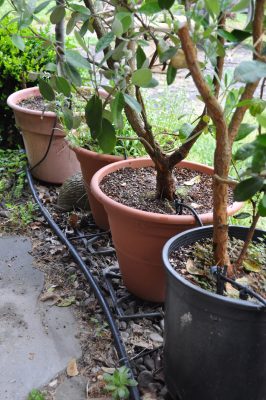 The fittings for wending water through tubes around corners and up into pots are low pressure fittings; the pressure lowers water pressure to a mere 20 psi.
The fittings for wending water through tubes around corners and up into pots are low pressure fittings; the pressure lowers water pressure to a mere 20 psi.
Once the 1/2 inch main line makes its way to a group of potted plants, a 1/4 inch plastic line, plugged into the main line with, of course, a low pressure fitting, carries the water up to the ground surface of each pot.
If the water merely exited at this point, pots closer to the water source would be under higher pressure and so get more water than those more distant. And pots that were shorter or at lower elevation would likewise get more water. So I slid an emitter, that reliably puts out 1/2 gallon of water per hour, no matter what the incoming water pressure, on the end of each 1/4 inch line.
Capillarity to the Rescue
I have a number of lowbush blueberry, lingonberry, hollyhock, carnation, and blazing star plants growing in pots 4-inches and smaller. I’ll eventually plant them out in the garden. Until then, the plants need regular watering Snaking 1/4 inch tubes to all these pots would create a tangled nightmare.
Enter capillary mat watering. All these smaller pots sit on a mat of absorbent fabric spread over a tray held a couple of inches above a pan of water. 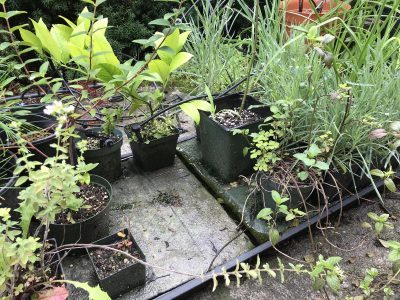 Part of the capillary mat dips into the reservoir of water, which gets sucked up into the mat and then sucked up into the potting soil through the drainage holes in each flat-bottomed plant pot.
Part of the capillary mat dips into the reservoir of water, which gets sucked up into the mat and then sucked up into the potting soil through the drainage holes in each flat-bottomed plant pot.
I periodically have to remember to add water to the reservoirs. Or, rather, “had to” because I ran a few of those drip tubes into the reservoirs, enough to keep them topped up with water to keep pace with plant use.
And a Presentation of Interest
I’ll be doing a presentation on August 18th on THE SCIENCE, ART, FUN, AND TASTY FRUIT OF ESPALIER in Copake Falls, NY. The presentation will explore the theory and the practice behind the pruning and orienting of branches to create an espalier. This decorative, usually 2-dimensional form, offers high yields of high quality fruit on a plant or plants that can be free-standing, decorating a wall or fence, or even creating the fence itself! I’ll go over which fruit plants work best and the branch pruning and orienting techniques that create and maintain espaliers that look good and yield especially delectable fruit. For more information, go to https://awaytogarden.com/8-18-open-day-plant-sale-lee-reich-espalier-talk-drip-irrigation-workshop/